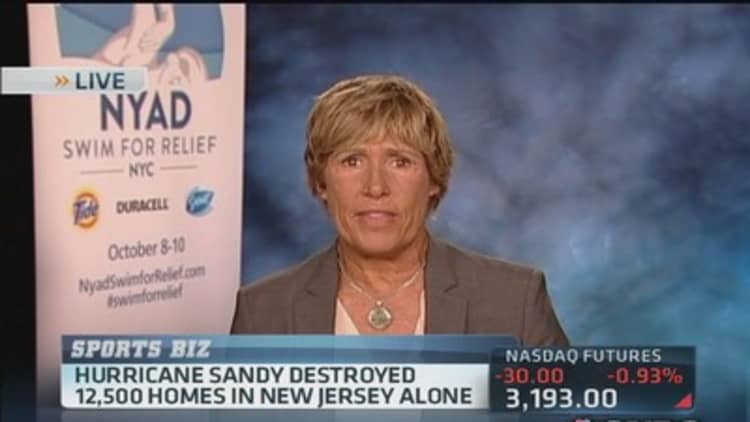Superstorm Sandy racked up nearly $70 billion in damages and killed more than 280 people, but one year after it struck on Oct. 29, 2012, business preparations for the next U.S. megadisaster remain very much a work in progress.
With more severe weather events hitting the U.S.— and likely to keep on hitting—experts say the country remains largely unprepared to handle catastrophes and their aftermath.
"The main lesson to take from Sandy is that we've had opportunities to learn from other storms for a long time—be it storms like Katrina, Agnes, or earthquakes, fire and flooding," said Scott Knowles, a history professor and disaster planning expert at Drexel University. However, "it's not a one-time lesson. We can't just move on from the events like we're doing without being better prepared."
(Read more: )
Even many who suffered directly from Sandy are failing to take steps to weather a future storm, said Greg Wank of the accounting firm Anchin, Block & Anchin.
"We just did a survey of some 266 small businesses in the New York City area on storm preparations and less than half say they are prepared for the next one," he said.
"That includes putting an emergency plan in place for workers, to having enough cash on hand to get through a business shutdown, or knowing what damage is covered by their insurance," Wank said.
Risks to infrastructure
Severe weather events put enormous stress on the nation's infrastructure, such as energy and water sources, leaving many victims in the dark without heat and even safe drinking water.
"We only lost around 2,000 customers from Sandy due to loss of power," said Jeff Sterba, CEO of American Water, which serves the Northeast as well as other parts of the U.S. and Canada.
"But the loss of electrical power meant we couldn't deliver safe, clean drinking water. We scrambled to move generators to the areas that needed power to treat and deliver water," he said.
"A storm like Sandy shows the weakness in our power grid," said Cam Dowlat of Nexans High Voltage USA, a firm that supplies products to energy companies. "You can take some preventative actions but they're never enough,"
"Power companies are doing their best to upgrade their systems by putting more cables underground instead of overhead, but it's expensive to do," Dowlat said.
Who will pay? Probably you
After Sandy, northeastern utility Consolidated Edison is spending some $240 million to upgrade 13 power substations in New York. The company is also spending $200 million to move power lines underground.
"Utilities can only upgrade so many things," Dowlat said. "The thing is to find someone to pay for this."
(Read more: Addicted to your smartphone? You're not alone)
The people paying more for a better energy grid or phone connection are likely to be the consumers of those services, said Seth Guikema, professor of geology at Johns Hopkins University.
"People will get higher costs to improve the system," he said. "We can't build a grid that's 100 percent reliable, but we do need to have a discussion on how to improve it. It could take billions of dollars to upgrade our national energy grid."
"Water prices are so low, but to make the system better, they will likely go up," said American Water's Sterba.
To try to head off power losses, many businesses and homes are turning to generators.
"We've seen an increase in business," said Al Prosser, a director of sales at MTU Onsite Energy, a maker of generators. "Homes are not our major market but all markets are seeing an uptick."
"Sandy brought awareness to having backup power," he said. "The storm exposed flaws in electrical design and in preparedness."
"Electrical systems are more complicated now with building codes and more points of failure," Prosser added. "When a storm or earthquake strikes, they can't respond like it's normal. And people demand more power for their computers, iPads and phones."
Flood insurance costs rising

Another area of preparation that's lacking is knowing what damage is covered by insurance, said Chris Loeber, a partner for insurance coverage at the law firm Lowenstein Sandler.
"A lot of policies have exclusions for flooding and storm damage, and Sandy was a wake up call for businesses to check their policies," Loeber said.
Only 18 percent of Americans have any kind of flood insurance coverage. For those who might want it, the price is going up. That's because subsidies to some policyholders for the federal government's flood insurance program—the National Flood Insurance Program, which is nearly the sole provider of flood insurance—are being phased out.
The program is hurting for cash after claim payouts from storms like Irene and Katrina. Its reported deficit is $28 billion. Hurricane Sandy alone cost the government more than $7 billion in paid losses.
As a result, Congress passed the Biggert-Waters Flood Insurance Reform Act in 2012. That act eliminates government subsides to some 20 percent of policyholders. In some cases, premiums could go as high as $20,000 a year.
But some analysts see this as a good way to control population expansion in flood areas.
"Biggert-Waters was a good reform bill as it goes a long way to moving to sustainability around floods," said Drexel University's Knowles. "It's a good to bring some good sense to coastal develpment."
"More than 39 percent of Americans live in coastal counties across the country," said Knowles. "That's a record number. We're not going to unbuild these areas, but we need to know the risk of development in these areas."
'We prepared in advance'

Of course, not everyone was caught flat-footed by Sandy.
"We prepared in advance after Hurricane Irene (in 2011)", said Lisa Goldstein, executive vice president and COO at the Hospital for Special Surgery in uptown Manhattan.
"We put in a series of things like submarine doors to keep the water out and moved our generators to higher floors and we had plenty of sump pumps in critical areas," she said. "And we had a huge team of employees ready for the storm."
"It does cost to do this, but it's the cost of doing business, and our patients come first," she added.
For those providing services during Sandy, it hasn't stopped them from improving their own ways of doing business.
"We didn't lose one customer during the storm, but we did a review after Sandy and found that our own workers couldn't come into the office," said Michael Gold, president of Intermedia, a cloud services provider.
(Read more: )
"Some of our own systems weren't available to our workers," because they couldn't get into the office, he said, but the company has since improved employees' ability to access internal systems via mobile devices.
Some business that ignored preparations in the past are now taking them to heart.
"Before Sandy, we didn't think about storm preparation, but now we are," said John Imor, tech director for Water Quality, a marine industry insurance firm located in lower Manhattan.
"Our building flooded and the power went out. But now we changed our phone systems to where the centers are out of the Northeast." he said.
"And we're putting in emergency measures to have people work in areas around their home, like a Starbucks or public library that has Internet access, if they can't get into the office," he said.
'Putting homes in wrong places'
Experts say getting the U.S. better prepared for severe weather is not going to be easy.
"A lot of communities are rebuilding the same way, and that's not making things better," said Illya Azaroff, chair of the American Institute of Architects for Design Risk and Recovery.
"We're still thinking of putting homes in places where weather patterns tell you you're at risk," he said.
"In New York City we will have 70,000 buildings that are in a flood plane," said Seth Pinsky, who was director of New York City's Special Initiative for Rebuilding and Resiliency, a post Sandy review of safety measures, that came up with a $20 billion plan for shielding the city from future storms.
"Even if we get the new buildings right, the old buildings are vulnerable to storms or other events," said Pinsky, who is now an executive at real estate investing firm, RXR Realty.
(Read more: How businesses can prepare for the next super storm)
One area that's overlooked when it comes to severe weather is the clean up, said Pinar Keskinocak, associate director of research for the Health Systems Institute at Georgia Tech.
"After Hurricane Katrina, debris removal accounted for more than 25 percent of total recuperation costs," she said.
In the end, preparing for the next disaster will take strong actions, said Azaroff.
"My hope is that we will get better prepared," he said. "People are becoming more aware of storms when they happen. But will we forget their impact and ignore getting prepared before they happen? That's the question."
Clarification: This story has been updated to reflect the fact that cloud services company Intermedia has taken measures to improve its workers' access to internal tools through mobile devices.
—By CNBC's Mark Koba. Follow him on Twitter @MarkKobaCNBC


